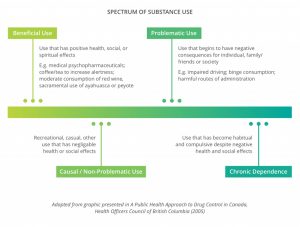The CU Umbrella Project embraces the notion of ‘substance use health’ which suggests that substance use not be considered in isolation but rather as an overall component of health and wellbeing. This way of thinking can be helpful in recognizing the links between substance use and mental health and wellbeing that can otherwise be viewed as independent of each other. Embracing the notion of substance use health ask us to reflect, ‘how does substance use relate to the other aspects of my physical, mental and social wellbeing?’. Thinking about substance use in this way also helps to reduce stigma by allowing for conversations about the perceived benefits or positive effects that a substance may have for an individual despite the risks it may present.
We all have relationships with substances in some form, whether that be making the intentional choice to abstain, experiment, or use socially. These relationships can be represented by looking at the spectrum of substance use; thinking in this way helps us to reflect on how substances factor into our lives in a broader sense.
The spectrum of substance use is a useful tool to help evaluate our relationships with the substances we use. People can move back and forth on the spectrum over time, often in relation to changes in their environment, social circles or wellbeing. The spectrum includes abstinence, experimental use, social use, unhelpful/problematic use, dependence and Substance Use Disorder. It is important to note that people to not progress along the spectrum in a linear fashion and can be at different places on the spectrum for each of the various substances they use. It is entirely possible for someone to be in the beneficial or low risk portion of the spectrum for one substance but encounter difficulties in regulating their use of another substance, exposing them to more risks as a result.

Within these stages, individuals can have different feelings and experiences with substances and there are also different levels within each stage. For instance, Substance Use Disorder has 3 levels of severity for diagnosis: mild, moderate, and severe.
A helpful way of checking in on your relationship with substances is to try and see where you are at on the spectrum. If you have concerns that you or someone you know might be having difficulty maintaining positive substance use health, you can use the 4 Cs to see if you have seen an increase of any of the following:
Craving: Intense craving for substance(s) akin to the need for food, sleep etc. Craving relates to the desire to feel the effects of a given substance, i.e the alertness that comes with caffeine or the stimulating effect of nicotine.
Control: Inability to exercise control or restraint in using substance(s). This can relate to the inability to control frequency of use or the amount of a substance used in a single session.
Compulsion: Strong urge or desire for substance(s). To differentiate from Craving, Compulsion if the urge to engage in the action or behavior associate with the substance, i.e the desire to have a cup of coffee or “go for a smoke”.
Consequences: Continuation of use of substance(s) despite unhelpful, negative, or even harmful or dangerous consequences.
If you or someone you know begins to see patterns in their use that demonstrate an increase of any of the 4 Cs, it could be a sign that they are heading toward the riskier side of the substance use spectrum. These can be good signs that it is time to reflect on our relationship with substances and potentially seek out some supports or resources if we need help making a change.
Importantly, the information provided here can generally apply to more than just substances and can be helpful in evaluating other potentially addictive behaviours such as gaming, gambling, or sex as well. For additional information on specific substances and ways to use safely, visit our Safer Use Strategies page.
